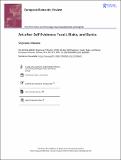Files in this item
Art after self evidence : Fuseli, Blake, and Banks
Item metadata
| dc.contributor.author | O'Rourke, Stephanie | |
| dc.date.accessioned | 2022-07-27T14:30:01Z | |
| dc.date.available | 2022-07-27T14:30:01Z | |
| dc.date.issued | 2022-07-25 | |
| dc.identifier | 280081781 | |
| dc.identifier | 3a680f5c-c34d-4a9c-b67c-ab3e69738aea | |
| dc.identifier | 85134838759 | |
| dc.identifier | 000829790600004 | |
| dc.identifier.citation | O'Rourke , S 2022 , ' Art after self evidence : Fuseli, Blake, and Banks ' , European Romantic Review , vol. 33 , no. 4 , pp. 497-513 . https://doi.org/10.1080/10509585.2022.2090699 | en |
| dc.identifier.issn | 1050-9585 | |
| dc.identifier.other | ORCID: /0000-0001-6823-4282/work/116598360 | |
| dc.identifier.uri | https://hdl.handle.net/10023/25728 | |
| dc.description.abstract | This article examines artworks by Henry Fuseli, William Blake, and Thomas Banks in relation to changing notions of “self evidence” at the turn of the nineteenth century. It considers how models of artistic neoclassicism and scientific experimental procedures shared an investment in the evidentiary authority of an idealized male body. Exploring the gendered and racial hierarchies operative in such an ideal, this article also charts its unraveling. | |
| dc.format.extent | 17 | |
| dc.format.extent | 3679749 | |
| dc.language.iso | eng | |
| dc.relation.ispartof | European Romantic Review | en |
| dc.subject | N Fine Arts | en |
| dc.subject | T-NDAS | en |
| dc.subject | MCC | en |
| dc.subject.lcc | N | en |
| dc.title | Art after self evidence : Fuseli, Blake, and Banks | en |
| dc.type | Journal article | en |
| dc.contributor.sponsor | The Leverhulme Trust | en |
| dc.contributor.institution | University of St Andrews. Centre for Energy Ethics | en |
| dc.contributor.institution | University of St Andrews. Centre for Contemporary Art | en |
| dc.contributor.institution | University of St Andrews. School of Art History | en |
| dc.contributor.institution | University of St Andrews. St Andrews Centre for the Receptions of Antiquity | en |
| dc.identifier.doi | 10.1080/10509585.2022.2090699 | |
| dc.description.status | Peer reviewed | en |
| dc.date.embargoedUntil | 2022-07-25 | |
| dc.identifier.grantnumber | RF-2019-195 | en |
This item appears in the following Collection(s)
Items in the St Andrews Research Repository are protected by copyright, with all rights reserved, unless otherwise indicated.

